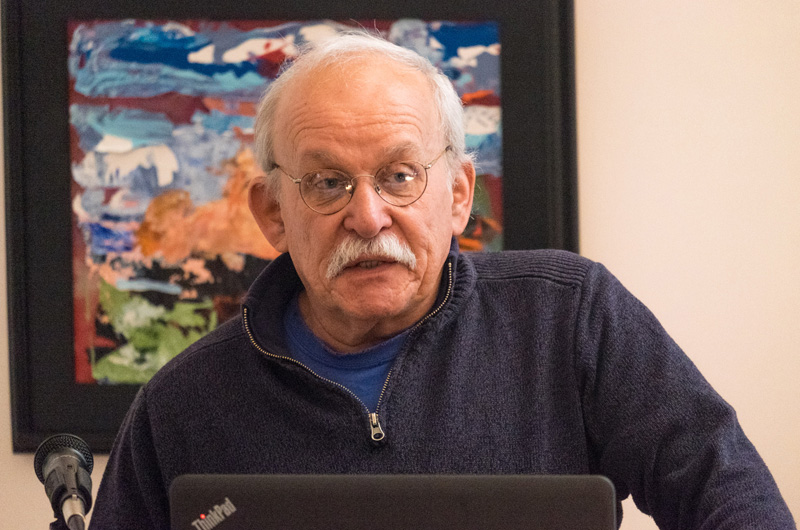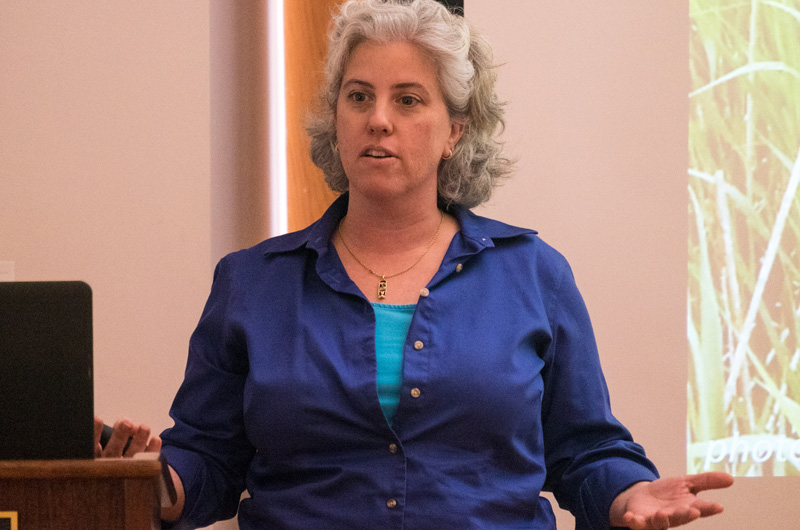Phragmites can be a valuable tool for removing nitrogen in Vineyard ponds, according to new research presented to a packed meeting in the West Tisbury library Monday afternoon.
Representatives from the Martha’s Vineyard Shellfish Group and partners showcased the results of a two-year study into the invasive reed.

Findings show that regular phragmites removal can be an additional, sustainable way to lower nitrogen levels in Vineyard ponds.
Results will now be reviewed by the Massachusetts Department of Environmental Protection.
The two-year study was funded by a $135,000 grant from the Environmental Protection Agency (EPA). A final report will be submitted to the EPA in mid-May for review.
“We are talking about harvesting phragmites, taking it away and hopefully doing something productive with it to remove nitrogen,” Emma Green-Beach, co-director of the shellfish group, told the crowd. “We are not proposing any planting or encouraging of the highly invasive plant.”
Rick Karney, director emeritus of the shellfish group, explained that reducing nitrogen by harvesting phragmites is a type of bio-remediation, or use of biological processes to extract offending nutrients, like nitrogen, from water.
According to the study results, the leaves of phragmites hold most of the nitrogen, so cutting the leaves and stalks instead of removing the entire plant is the ideal strategy for extracting the nutrient. If cut out entirely, the phragmites could grow back taller and more dense than before.

Nitrogen makes its way into Island pond ecosystems primarily through wastewater from residential septic systems that mixes with the groundwater surrounding the pond. Extensive estuary studies have been done by the state and the Martha’s Vineyard Commission in recent years.
“I’m sure everyone is aware of the nitrogen problem,” Mr. Karney said. “If we don’t do something about this nitrogen then we’re going to lose our shellfish.”
Water sampling over the past two years of Lagoon Pond and Chilmark Pond by a team led by Sheri Caseau, water resource planner for the Martha’s Vineyard Commission, backed up Mr. Karney’s concerns. Both ponds were above the nitrogen threshold at every station sampled.
The three ponds that were part of the shellfish group study: Lagoon Pond, Farm Pond, and Chilmark Pond, suffer from high nitrogen levels. Nitrogen loading for each pond is above the target for maximum average total nitrogen concentration set by DEP, according to estuary studies.
Chilmark Pond was singled out as an area with great potential for phragmites harvesting due to its high phragmites density (more than 10 acres) and nitrogen levels.
The shellfish group study found that the pond needs to reduce nitrogen loading by 840 kilograms a year to reach the DEP nitrogen loading target. Since dense phragmites at Chilmark Pond holds more nitrogen than other locations, the study found that removing just eight and one half acres could reduce the required nitrogen loading alone.
July would be the best time to do the harvest, explained Jamie Vaudrey from the University of Connecticut Department of Marine Sciences. This is because the reed holds more nitrogen when it is small and contains less and less as it grows taller, typically peaking in the fall. In winter the plants are less active and store nitrogen in the roots.
Ms. Vaudrey said the stalks become more difficult to remove as they get taller.
“Ideally we would like to do as little work as possible,” she said. “It’s best to get the phragmites when it’s small as possible but also as rich with nitrogen as possible.”
Kristen Fauteux, director of stewardship for the Sheriff’s Meadow Foundation, provided a land manager’s perspective on the study since phragmites are present on many of the foundation’s properties. She spoke in favor of the harvesting over cutting them out entirely, echoing that they often grow back larger and more dense than before.
Ms. Fauteux said more thought should be given to how and where the phragmites would be harvested. She said some plant populations are in dense and hard to reach areas.
Spreading phragmites is also illegal in Massachusetts, so she said any harvest program must be wary of unintentionally making the problem worse.
“We are really excited about this project,” said Ms. Fauteux. “But more research needs to be done to make sure we don’t spread phragmites as we go about harvesting it.”
Nathaniel Mulcahy of the company Worldstove detailed how phragmites can also be a valuable source of energy after they are removed by being ground into pellets that produce a high-quality combustible gas.
Mr. Karney and Ms. Vaudrey emphasized that phragmites harvest is just one tool for lowering nitrogen levels in the environment. Mr. Karney said later that if the study clears the DEP, Island towns can consider funding a removal program.
“It may sound like a drop in the bucket,” he said. “But we can grow millions of oysters and if there’s no clean water to put them in, then we’re just spinning our wheels and racing time.”








Comments (1)
Comments
Comment policy »